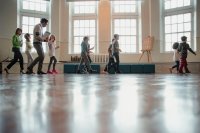The Biggest Lesson of My First Year Teaching
A veteran teacher shares how she learned the value of prioritizing relationships when she was just starting out in the classroom.
Overwhelming is the word that best describes my first year of teaching. I wasn’t prepared for the multitude of things on my plate. I didn’t have a handle on classroom management, and I left each day feeling exhausted and defeated.
My time was spent learning new curriculum, developing personalized learning techniques, modifying lessons, and analyzing data. I knew this was important work, but I also knew that something was not working. I felt a disconnect in my classroom and knew I could do better.
I looked around and saw that there were some teachers who seemed to just take everything in stride and really enjoyed what they were doing. Their classrooms ran smoothly, and their students looked happy. To figure out what they were doing that set them apart, I made an effort to study three teachers during my first year.
I asked if I could sit in and observe their classes. Over a few months, I observed these teachers around five to seven times, for approximately 20–30 minutes each time. I usually planned these observations during my prep or lunch, but on occasion I was able to bring in a substitute teacher for my classes to create observation time.
I also watched teachers interact with students outside of the classroom: on the playground, during lunch, in the hallway, and in assemblies. I paid attention to conversations, comments, and attitudes.
Lessons Learned
I started to see that the highest priority for these teachers was forming relationships with students—everything else fell into place after that.
One teacher played basketball with kids every Friday during lunch. Another sat with kids in the lunch room a few times throughout the year. There was the teacher who liked to walk during her lunch and would invite different groups of kids to join her for conversation. I watched a kindergarten teacher meet a different parent in the pickup line after school each day to let them know of something great that happened with their child.
Some of what I noticed was more time intensive. One colleague did 15-minute morning meetings and ended the day with a short reflection, asking kids to share one thing that went well that day and possibly one goal they were working on for the remainder of the week.
One teacher attended their students’ sporting and musical events, while another came early every day to meet a struggling student and preview the math lesson for the day.
I knew I wanted to model myself after these teachers, so I made a gradual, conscious shift—changing my priorities to make my relationships with students my main focus. I started out with a morning meeting. This was something I could implement easily. I started to gather my students in a circle at the beginning of the day. We did different class greetings and then had either a game or a discussion. I used this time to give short announcements and go over the day’s schedule.
Making this shift changed me as a teacher, and it changed the vibe in my classroom. I began to feel happier at school, and I could see that my students were happier too. They were more prepared to tackle the day.
They trusted me and felt more comfortable asking questions and taking risks. They were reaching out for help and clarification more than ever before. The discipline problems I had been having started to decrease, and honestly, the school day was so much more enjoyable for all of us. We were building trust and friendships, and the students knew that I was on their side and willing to help. Parents would reach out more, and I started to hear that kids really enjoyed being in my class. I never abandoned my work on curriculum, data, differentiation, and all of the other things that are essential in a classroom, but I did shift my priorities.
How to Make Time for Relationships
I’ve been teaching for over 15 years now, am National Board certified, and serve as a mentor to other teachers going through the National Board certification process. New teachers often ask me where I find the time to build relationships in the classroom. I always tell them that it should be the first thing they build into their plans. Prioritize it at the beginning of the year and continue it each day. Just as one allocates time to teaching procedures, an equal amount of time should go into building community and getting to know students.
I let teachers know that it’s helpful to spend time at the beginning of the year telling students about themselves. To the level that they’re comfortable with, educators can let students know about their pets, family, and things they like to do outside of school. And vice versa, it’s helpful to find out information about students. Sending home a parent questionnaire enables caregivers to share personality traits, strengths, and weaknesses—valuable insight into students’ lives and how they learn.
Building in a morning meeting each day is a great way to foster relationships and to gauge students’ emotions.
Scheduling fun small group activities so that kids can get to know each other and feel comfortable working with different students is a small commitment with a big payoff.
One of my favorite classroom games is Who Is It? Each student writes two to three unique things about themselves on a Post-it note with their name. I collect the notes and read them to the class, and they have to guess who wrote it.
Trying out one new thing is a great starting point. For new teachers, it’s important not to overcommit. Burnout is too serious of an issue. A simple conversation, a question, a walk, or a game can make the classroom a great place to be.
